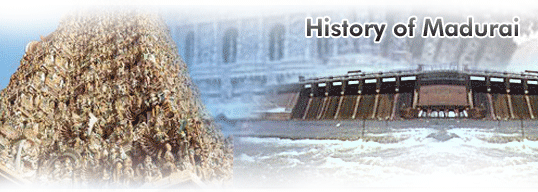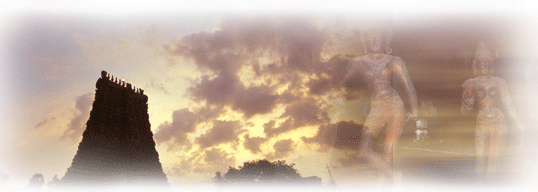 present day city of Madurai is said to have been known as Kadambavanam, a forest. Lord Indra was worshipping Swayambhu, the Lingam in the forest which was noticed by Dhananjaya, a farmer. The Lingam was under the Kadamba tree. The reported about what he saw in Kadambavanam to King Kulasekara Pandiya. present day city of Madurai is said to have been known as Kadambavanam, a forest. Lord Indra was worshipping Swayambhu, the Lingam in the forest which was noticed by Dhananjaya, a farmer. The Lingam was under the Kadamba tree. The reported about what he saw in Kadambavanam to King Kulasekara Pandiya.Thus the kind ordered to clear the forest in the place and to build a temple around the Lingam. With the temple as the center, a city was soon planned and developed. When the city was created it is said that a drop of honey fell on the town from the hair of Lord Shiva who appeared. Thus the city was named as Mathuram, meaning sweetness in Tamil, which is now changed to Madurai. Lord Shiva has performed about sixty-four wonders called "Thiruvilaiyadals" in the city of Madurai and thus Madurai occupies a very important place in the history. Megasthanes visited Madurai in the 3rd century BC and the place is said to be visited by many people from Rome and Greece and they were involved in the trade with the Pandiya Kings who were ruling over the place in those days. |
Madurai is said to have flourished in the 10th century AD which was the time when the Pandiyas rule was captured by the Cholas. From 920 AD till the beginning of the 13th century, Madurai was ruled over the Cholas. The Madurai was captured again by the Pandiyas and they ruled the place from 1223 AD. It was the Pandian Kings who spread the language of Tamil and many master pieces in the Tamil language like “Silapathikaram” is said to have been created in the days. Malik Kafur, the general of Alauddin Khilji who was ruling over the region of Delhi had raided Madurai in the year 1311 for precious stones, jewels and gems. Then Madurai was raided by many other Muslim rulers. Madurai became a province of the Delhi Empire in the year 1323 which came under the rule of the Tughlaks. The Vijayanagar Dynasty of Hampi came in the year 1371 to capture Madurai. In those days, the Vijayanagar Empire Kings has appointed people who were called by the name Nayaks to rule their places. In return the Nayaks paid some fixed amount to the Kings. |
 |
When Krishna Deva Raya, one of the Kings of the Vijayanagar Empire died in the year 1530 AD, the Nayaks took over the territories and began to rule them. Thirumalai Nayak is one of the famous Nayaks who is still famous among the people in Madurai. He ruled over the place from 1623 to. 1659. The Thirumalai Nayak has created many magnificent structures in the city like the Raja Gopuram of the Meenakshi Amman Temple, The Thirumalai Nayakar's Palace and the Pudu Mandapam which are still places visited by the people. It was in the year 1781 that Madurai began to be ruled by the British and the first collector for Madurai was George Procter. In the early days Madurai and Dindugal were situated in the same district which was then separated. Today in the state of Tamil Nadu, Madurai stands as an important city that connects the Northern and the Southern Tamil Nadu with 15 State Assembly constituencies and two parliament constituencies. Another famous thing that attracts people in Madurai is the Jasmine flowers. It is being sent to the other parts of India and also exported to foreign countries |
Manikkavasagar, the author of "The Thiruvaachakam" (the great Upanishad in Tamil), is said to have been born in Vadhavoora, a village seven miles from modern Madurai, on the banks of river Vaigai. He was the illustrious minister of Pandinaadu. Once, Manikkavasagar was given money by the Pandiyan King to buy horses for the cavalry. But he used the money to renovate the dilapidated temple at Thiru-p-perunthurai. He knew that the cavalry is in urgent need of remounts. But, when he arrived at Thirupperunthurai, he saw that the temple was in more urgent need of renovation. So he diverted the money for the renovation of the temple, an act well within his powers of discretion. He was not misappropriating the state funds.If anyone was in the wrong, it was the king who was in the wrong. Manikkavasagar was put into prison.This was the reason why Lord Shiva chose to teach the king, the evanescent nature of faith in power based on an army. It was therefore that he made the howling jackals turn into cavalry horses. Lord Shiva reached Madurai with the horses. The king was pleased and he released Manikkavasagar.On the same day, (midnight) all the cavalry horses turned into howling jackals. The message reached the king through his soldiers. Whereupon, the king threw Manikkavasagar into prison. Mundane justice was satisfied,the ends of the law of karma was fulfilled. But divine law had been forgotten by the king. Lord Shiva made the perenially dry Vaigai rise in devasting flood. The king had to be taught a lesson and Manikkavasagar too had to learn a lesson - an elementary lesson in the service of god. Pandiyan king ordered every family in Madurai to send one man for each family to help to throw embankments to contain the waters of Vaigai. Prisoners, who were the first people to be pressed into service in such emergencies even in those days would not have been spared by Pandiyan. So, Manikkavasagar was there with his basket frantically throwing hods of mud into the hungry waters of the Vaigai. An old lady Vanthi, who used to sell "Pittu" could not send anyone from her family to throw embankments to contain the waters of Vaigai.The lady was a disciple of Lord Shiva . So, Lord Shiva planned to help the old lady and he appeared as a labourer infront of her.She, being a poor lady said that she will give him "Pittu" instead of money if he is ready to throw mud into Vaigai river. He accepted to carry mud in his head and throw it into the waters of Vaigai. He was very lazy used to sleep after eating "Pittu". The Pandiyan King came to know about Vanthi's servant through his soldiers. He ordered his Soldiers to bring him . Then the king started beating him on his back.Immediately, Lord Shiva, who was the servant of Vanthi disappeared after throwing a basket of mud into Vaigai. The king then realised that it was Lord Shiva who came as servant to rescue Manikkavasagar. Thus Lord Shiva taught the Pandiyan king - a much needed lesson in righteous kingship. To commemorate this historical incident,'Avani Festival' is celebrated every year in the month of 'Avani'. This is another important festival next to 'Chithirai Festival'. |
Lord Shiva performed "Thiruvilayadals" for poets who prayed to him for succour. Once the Pandiyan king had a doubt as to whether the scent from a woman's hair was natural or artificial. He announced a price of 1000 gold coins for anyone who clear his doubt. A poor poet named Tharumi prayed to Lord Shiva to make him get the award. The Lord gave a poem to the poet and asked him to take it to the King. When this poem was read in the court, Poet Nakkeerar found fault with it and stopped the giving of the prize. Alas! Tharumi's grief grew and he again appealed to the Lord. He said he was not for not receiving the prize but he could not bear anyone finding fault with the Lord's poems. Thereupon, Lord Shiva himself came to the court and challenged Nakkeerar. But Nakkeerar could not be cowed down. Though the divine poet asked him if the hair of Ganapoongodai,the consort of Lord Kalathinathar,whom Nakkeerar worshipped ,did not have the natural scent,the undaunted Nakkeerar asserted that it was so. Suddenly the Lord opened the eye in his forehead (Netrikkan) which emitted fire and looked at Nakkeerar to show the poet who he was. Even then, Nakkeerar persisted in his statement. As he could not bear the scorching heat, emanating from the divine eye he jumped into the water of the Golden Lotus Tank. Then at the request of the other poets, the Lord took Nakkeerar out of the tank, forgave him and made him study under 'Agasthiar', the Tamil Sage. |
Alauddin Khilji, who was the successful ruler in North India wanted to occupy Tamil Nadu. So he sent his Army Chief Malik Kafur to Madurai. He attacked Madurai in the year 1310. He easily won the battle as the then Pandiyan king Veerapandiyan lacked a powerful army. He also planned to destroy the Madurai temple after capturing the fort. One of Malik Kafur's soldiers by name "Thiruvegambarayan" came to see the temple. He noticed eight elephant statues around the main Garpagraha. He asked a saint who was sitting in the "Siththar Sannidhi" about those elephants.The saint told him about the "Thiruvilayadals" of Lord Shiva.Once Lord Shiva came as "Siththar" and gave those elephants sugarcane. He asked the saint whether it will happen even today. "Thiruvegambarayan" who felt surprised informed Malik Kafur about the elephant statues. Malik Kafur came to the temple to see those statues. Malik Kafur was given sugarcane by the saint to feed the elephants. To everyone's surprise the stone elephant stretched its trunk and ate the sugarcane. Malik Kafur was astonished. He said," Truly, god is present here only". He also ordered his soldiers to stop destructing the temple. The temple was thus saved from demolition. When they attempted to know about the saint, he was not there.It was Lord Shiva who incarnated as the saint to rescue the temple. |
| |
|
Yaanai Malai
Yaanai malai is situated at a distance of 9 Kms east of Madurai. Since it appears as if an elephant is lying with its legs stretched, the mountain has been named so. It seems that a large number of elephants have lived in this forest area which is located around Kadambavanam, two thousand years back. So this mountain is called as "Yaanai Malai". Our historical legends say that Samanars lived in this forest. Caves were built in these mountains for their shelter. During the period when Samanars dominated the scene in Tamil Nadu, Jain Saints lived in the places around Madurai. These Jain Saints have lived in eight mountains.
Among them, the important mountains are Yaanai Malai, Naga Malai and Sunanga Malai. "Brahmi" Scripts are inscribed in the caves of Yaanai Malai.Archeologist say that these scripts are two thousand years old. The Pandiyan king "Nedunchadayan Paraanthagan" ruled Madurai in 8th Century A.D. He was a Saivite who later became a Vaishnavite. He was inspired by Periyalwar. "Maarankaari" who was the minister of Paaranthagan built a temple for "Narasinga Perumaan" in 770 A.D. in Yaana Malai. After his death, his younger brother "Maaran" built a entrance (Muga Mandapam) for the temple.
All these information are known from the inscriptions of Yaanai Malai. There is a belief that Samanars sent elephants,snakes and pigs to assault Lord Shiva. But Lord Shiva cursed them to become stones. According to "Thiruvilayaadal Puranam" when elephant was used as a weapon to attack Lord Shiva, he killed it with a bow called "Narasinga" (Narasinga Ambu). Vaishnavites captured Yaanai Malai from Samanars and made the quit Ys anai Malai.


0 comments:
Post a Comment